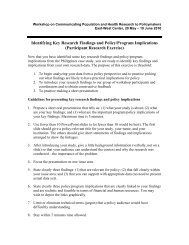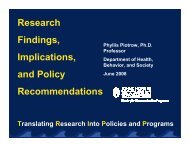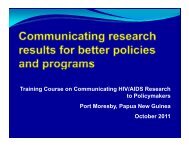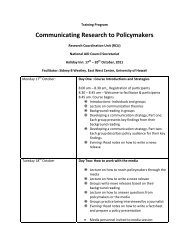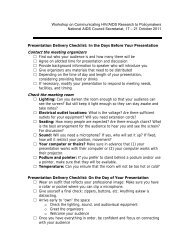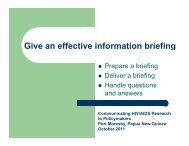Tools for Behavior Change Communication - K4Health
Tools for Behavior Change Communication - K4Health
Tools for Behavior Change Communication - K4Health
Create successful ePaper yourself
Turn your PDF publications into a flip-book with our unique Google optimized e-Paper software.
INFO<br />
REPORTS<br />
<strong>Tools</strong> <strong>for</strong><br />
<strong>Behavior</strong> <strong>Change</strong><br />
<strong>Communication</strong><br />
INFO Project<br />
Center <strong>for</strong> <strong>Communication</strong><br />
Programs<br />
CONTENTS<br />
Checklist: BCC Program Cycle ...p. 2<br />
Family planning program managers<br />
can use this checklist to help plan,<br />
carry out, and evaluate BCC programs.<br />
Budgeting <strong>for</strong> BCC....................p. 4<br />
This table identifi es major costs to<br />
include in the BCC budget.<br />
Model of an Audience Profile....p. 5<br />
This model can help the BCC<br />
program team to create an audience<br />
profi le. The profi le helps in developing<br />
messages and materials that will<br />
move the audience.<br />
Checklist: Ensuring<br />
Good-Quality Materials ............p. 5<br />
This checklist can help program<br />
managers determine whether the<br />
creative team is developing goodquality<br />
messages and materials.<br />
Checklist: Working With<br />
the News Media........................p. 6<br />
This checklist can help program<br />
managers work with the news<br />
media to reach the public.<br />
Types of Evaluation: Purpose,<br />
Questions Answered, and<br />
Sample Indicators.....................p. 7<br />
This table can help program<br />
managers understand how to<br />
measure progress towards objectives.<br />
Bibliography.............................p. 8<br />
Many health and development programs use behavior change<br />
communication (BCC) to improve people’s health and wellbeing,<br />
including family planning and reproductive health, maternal and<br />
child health, and prevention of infectious diseases. BCC is a process<br />
that motivates people to adopt and sustain healthy behaviors and<br />
lifestyles. Sustaining healthy behavior usually requires a continuing<br />
investment in BCC as part of an overall health program.<br />
The tools in this issue of INFO Reports are meant to help with<br />
planning and developing a BCC component in family planning<br />
programs. The same tools can be used, however, <strong>for</strong> any healthor<br />
development-related BCC program. This report is part of<br />
a set of publications on behavior change communication.<br />
Other publications in the set are Population Reports,<br />
“<strong>Communication</strong> <strong>for</strong> Better Health,” and INFO<br />
Reports, “Entertainment-Education <strong>for</strong><br />
Better Health.”<br />
January 2008 • Issue No. 16<br />
See companion Population Reports,<br />
“<strong>Communication</strong> <strong>for</strong> Better Health.”<br />
Also see companion INFO Reports,<br />
“Entertainment-Education<br />
<strong>for</strong> Better Health.”
CHECKLIST:<br />
<strong>Behavior</strong> <strong>Change</strong> <strong>Communication</strong> Program Cycle<br />
How to use this tool: Family planning program managers can<br />
use this checklist to help plan, carry out, and evaluate BCC<br />
programs. The checklist refl ects the communication program<br />
processes of several organizations (see list of sources at end of<br />
checklist). Each organization’s process has different names <strong>for</strong><br />
the steps, but they include common elements.<br />
Each step highlights, in a colored box, tips <strong>for</strong> engaging the<br />
participation of members of the intended audience and other<br />
key stakeholders.<br />
STEP 1 : Analysis<br />
Understand Dynamics of the Health Issue<br />
c Determine severity and causes of the health issue, noting<br />
differences by audience characteristics such as gender and<br />
ethnicity.<br />
c Identify possible health-related behaviors that could be<br />
encouraged or discouraged.<br />
c Identify social, economic, and political factors blocking or<br />
facilitating desired behavior changes.<br />
c Develop problem statement that summarizes the above<br />
points to help identify what aspects of the health issue can<br />
be addressed through communication.<br />
Understand Audience and Other Potential<br />
Participants in the Program (Formative Research)<br />
c Identify primary audience (people who are at risk of or are<br />
suffering from the health problem) and secondary audiences<br />
(people who infl uence health behaviors of primary<br />
audience).<br />
• Collect in-depth in<strong>for</strong>mation about the audience: What<br />
are their knowledge, attitudes, and beliefs about health?<br />
What factors affect their health behaviors? What are<br />
their media habits? What access do they have to in<strong>for</strong>mation,<br />
services, and other resources? Where do they<br />
currently stand in the stages of behavior change?<br />
• Are there different groups of people who have<br />
similar needs, preferences, and characteristics<br />
(audience segments)? Will the BCC program need<br />
customized messages and materials to suit audience<br />
segments?<br />
• Develop a profi le, or description, of each audience<br />
segment to help the creative team develop effective<br />
messages and materials later (see p. 5 <strong>for</strong> a tool).<br />
c Conduct participant analysis.<br />
• What other people or groups can participate in the<br />
BCC program (partners, stakeholders, allies, and<br />
gatekeepers)? These may include nongovernmental<br />
organizations, professional associations, schools,<br />
faith-based groups, and the media. What skills or<br />
resources can they offer? What would motivate their<br />
participation?<br />
c Conduct channel analysis.<br />
• What communication channels are available?<br />
• What are the strengths and weaknesses of each channel?<br />
For example, how effective are the channels in reaching<br />
the audience? How many people can they reach?<br />
Engage community participation<br />
• Be open and public about the program’s objectives.<br />
Respond to the audience’s expressed needs.<br />
• Involve audience members and other key stakeholders<br />
in the analysis of their own concerns. Participatory<br />
techniques include scoring and preference ranking<br />
(community members weigh different problems or<br />
program options as to how well they meet various<br />
criteria) and community mapping and modeling. In<br />
this process community members draw a map of their<br />
community to identify what programs are available<br />
and where they may be needed most.<br />
This report was prepared by Ruwaida M.<br />
Salem, MPH, Jenny Bernstein, MPH,<br />
and Tara M. Sullivan, PhD. Edited by Ward<br />
Rinehart. Designed by Prographics, Inc.<br />
The INFO Project appreciates the assistance<br />
of the following reviewers: Jane Bertrand,<br />
Gloria Coe, Gael O’Sullivan, Michael Stalker,<br />
and Scott Wittet.<br />
Suggested citation: Salem, R.M., Bernstein, J.,<br />
and Sullivan, T.M. “<strong>Tools</strong> <strong>for</strong> <strong>Behavior</strong> <strong>Change</strong><br />
<strong>Communication</strong>.” INFO Reports, No. 16. Baltimore,<br />
INFO Project, Johns Hopkins Bloomberg School<br />
of Public Health, January 2008.<br />
INFO Project<br />
Center <strong>for</strong> <strong>Communication</strong> Programs<br />
Johns Hopkins Bloomberg<br />
School of Public Health<br />
111 Market Place, Suite 310<br />
Baltimore, MD 21202 USA<br />
410-659-6300<br />
410-659-6266 (fax)<br />
www.info<strong>for</strong>health.org<br />
infoproject@jhuccp.org<br />
Earle Lawrence, Project Director<br />
Vidya Setty, Senior Editor<br />
Heather Johnson, Production Manager<br />
INFO Reports is designed to provide an accurate<br />
and authoritative report on important developments<br />
in family planning and related health issues. The<br />
opinions expressed herein are those of the authors<br />
and do not necessarily refl ect the views of the U.S.<br />
Agency <strong>for</strong> International Development (USAID)<br />
or Johns Hopkins University.<br />
Published with support from USAID, Global, GH/PRH/PEC, under the<br />
terms of Grant No. GPH-A-00-02-00003-00.<br />
Available online at: http://www.info<strong>for</strong>health.<br />
org/in<strong>for</strong>eports/<br />
2
STEP 2 : Strategic Design<br />
c Defi ne communication, behavior change, and program<br />
objectives.<br />
• <strong>Communication</strong> objectives describe desired changes in<br />
indirect infl uences on behavior, such as knowledge, attitudes,<br />
and social norms. <strong>Behavior</strong> change objectives refer<br />
to intended changes in the audience’s actual behavior.<br />
Together, communication and behavior change objectives<br />
contribute to the overall program objective, which refers<br />
to anticipated results of the overarching health program.<br />
• Are objectives SMART: Specifi c, Measurable, Appropriate,<br />
Realistic, and Timebound? (see companion Population<br />
Reports, p. 12)<br />
c Develop a conceptual framework to show how program<br />
activities are expected to contribute to objectives.<br />
c Use the conceptual framework to help select monitoring<br />
and evaluation indicators.<br />
• Are indicators valid—that is, do they measure the topic<br />
or issue that they are meant to refl ect? Are indicators<br />
reliable—that is, do they produce consistent results<br />
when repeated over time? Are they specifi c (measure a<br />
single topic or issue), sensitive (responsive to change),<br />
and operational (measurable)?<br />
c Prioritize communication channels.<br />
• Use relevant behavioral theories and fi ndings from<br />
<strong>for</strong>mative research to guide the choice of channels.<br />
• To help maximize effect, can the program use a mix of the<br />
three major types of channels—mass media, interpersonal,<br />
and/or community channels?<br />
c Develop a creative brief to share with people and organizations<br />
involved in developing messages and materials.<br />
• Does the brief include a profi le of the intended audience,<br />
behavior change objectives, resulting benefi ts that<br />
the audience will appreciate, channels that will carry the<br />
messages, and the key message points?<br />
c Draw up an implementation plan, including activities,<br />
partners’ roles and responsibilities, timeline, budget,<br />
and management plan.<br />
c Develop a monitoring and evaluation plan.<br />
Engage community participation<br />
• Select participants who work with or represent those most<br />
directly affected by the health issue; ensure fair representation<br />
of women and marginalized groups.<br />
• Facilitate their involvement in strategic design workshops by<br />
using appropriate exercises and “games.”<br />
• Hold workshops at locations in the community at times that<br />
are convenient <strong>for</strong> them.<br />
STEP 3 : Development and Pretesting<br />
c Develop messages and materials.<br />
• Use fi ndings from <strong>for</strong>mative research and the strategic<br />
plan to guide development. The creative brief and<br />
audience profi les developed in Step 2 summarize this<br />
in<strong>for</strong>mation.<br />
• Tailor messages to the audience’s stage of behavior<br />
change.<br />
• Choose type of appeal, such as empowering or entertaining,<br />
and tone, such as humorous or authoritative.<br />
c Pretest messages and materials with audience members.<br />
c Revise messages and materials based on pretesters’<br />
reactions.<br />
Engage community participation<br />
• Form an advisory group made up of key stakeholders<br />
close to or representing the audience. Advisory groups<br />
can provide useful advice about developing appropriate<br />
messages and materials and can help with revisions after<br />
pretesting.<br />
• Invite audience members to suggest messages and materials.<br />
STEP 4 : Implementation and Monitoring<br />
c Develop and implement a dissemination plan.<br />
c Manage and monitor program progress—activities, staffing,<br />
budget, and responses of the audience and other<br />
stakeholders.<br />
c Make midcourse adjustments to the program based on<br />
monitoring results.<br />
Engage community participation<br />
• Mobilize a large number of stakeholders to help implement<br />
activities and develop a broad sense of ownership.<br />
• Offer different means and levels of participation during<br />
implementation. For example, <strong>for</strong> a radio program, audience<br />
members can participate in listening groups, suggest<br />
questions <strong>for</strong> the program, or even start a community radio<br />
program.<br />
• Include audience members and other stakeholders in<br />
steering committees to oversee program implementation,<br />
make recommendations, and ensure action to improve<br />
activities.<br />
3
STEP 5 : Evaluation<br />
c Measure outcomes, assess impact.<br />
c Disseminate results to partners, key stakeholders, the news<br />
media, and funding agencies.<br />
c Record lessons learned and archive research fi ndings <strong>for</strong><br />
use in future programs.<br />
c Revise or redesign program based on evaluation fi ndings.<br />
Sources: Cabañero-Verzosa 2003 (3), Figueroa et al. 2002 (6), GreenCOM 2004 (8),<br />
Health <strong>Communication</strong> Partnership 2003 (9), National Cancer Institute 2001 (13),<br />
O’Sullivan et al. 2003 (14), Synergy Project 2006 (18), Tapia, Brasington, and Van Lith<br />
2007 (19), U.S. CDC 2006 (21), UNICEF and WHO 2000 (24), and WHO 2003 (25)<br />
Engage community participation<br />
• Involve audience members in evaluating the program<br />
against parameters they set themselves (participatory<br />
evaluation). Ask what they want to know and why, how<br />
they can help conduct the evaluation, and how they will<br />
use the results.<br />
• Encourage involvement of audience members in experimental<br />
evaluations (designed to measure outcomes<br />
objectively). Share key fi ndings of the experimental evaluation<br />
with audience members and of the participatory<br />
evaluation with other stakeholders.<br />
• Encourage participants from the audience to share evaluation<br />
fi ndings with their communities, advocate further<br />
activities, and spread activities to other communities.<br />
Budgeting <strong>for</strong> <strong>Behavior</strong> <strong>Change</strong> <strong>Communication</strong><br />
How to use this tool: This table helps program managers<br />
identify the major areas of costs <strong>for</strong> typical BCC programs. To<br />
estimate the actual funding needed <strong>for</strong> each category in the<br />
budget, program staff should obtain quotations from contractors.<br />
In developing a budget, the program allocates its fi nancial<br />
resources so as to be sure that all steps and activities can be<br />
carried out.<br />
Activities<br />
Possible Costs<br />
• Personnel salaries and benefi ts;<br />
consultant fees<br />
• Training <strong>for</strong> data collection<br />
• Travel allowances <strong>for</strong> fi eld work<br />
• Supplies<br />
• Data processing and analysis<br />
• Report writing<br />
• Meetings <strong>for</strong> planning<br />
Activities<br />
Production of<br />
print materials<br />
Possible Costs<br />
• Fees/salaries <strong>for</strong> writers, artists, and graphic<br />
designers<br />
• Copywriting and editing<br />
• Typesetting<br />
• Pretesting of all print materials, including<br />
posters, brochures, and training curricula<br />
• Printing and distribution<br />
<strong>Communication</strong><br />
research and<br />
planning<br />
Monitoring and<br />
evaluation<br />
Training and<br />
capacity<br />
development<br />
(throughout the<br />
BCC program<br />
process)<br />
• Development, distribution, and collection<br />
of monitoring and evaluation<br />
questionnaires<br />
• Orientation of trainers and training of<br />
fi eld workers<br />
• Travel allowance <strong>for</strong> supervision and/<br />
or quality assurance of data collection<br />
• Compilation and analysis of data<br />
• Organization of feedback session(s)<br />
• Fees/salaries <strong>for</strong> evaluators<br />
• Curriculum development<br />
• Consultants’ and trainers’ fees<br />
• Per diem and accommodation <strong>for</strong> participants<br />
• Training materials<br />
• Equipment purchase or rental<br />
• Hiring of training site<br />
Production of<br />
broadcast<br />
materials<br />
Special events<br />
Other<br />
• Fees/salaries <strong>for</strong> artists, scriptwriters,<br />
producers, videographers, and technicians<br />
• Copywriting<br />
• Studio and equipment rental<br />
• Technical content reviewers<br />
• Pretesting of broadcast materials<br />
• Airtime<br />
• Distribution<br />
• Give-aways—<strong>for</strong> example, stickers and<br />
T-shirts<br />
• Press conferences and kick-off events<br />
• Honoraria <strong>for</strong> dignitaries, celebrities<br />
• Hiring of sites, public address system,<br />
other equipment<br />
• <strong>Communication</strong>—telephone, Internet<br />
access, fax, postage<br />
• Administrative and overhead costs<br />
• Other transportation<br />
Sources: Cabañero-Verzosa 2003 (3), O’Sullivan et al. 2003 (14), UNICEF 1999 (23),<br />
and Younger et al. 2001 (27)<br />
4
Model of an Audience Profile<br />
How to use this tool: To help the creative team to develop effective<br />
messages and materials, the program team should tell a story<br />
about typical audience members. To do this, they create a profi le<br />
that embodies the characteristics of the audience. The program<br />
and creative teams can imagine the audience as a specifi c person<br />
rather than as a collection of statistics.<br />
The BCC program can collect in<strong>for</strong>mation about the audience from<br />
existing data such as Ministry of Health statistics or health and<br />
population surveys. The program’s <strong>for</strong>mative research can provide<br />
detail. Characteristics to consider include age, sex, marital status,<br />
place of residence, occupation, income level, years of schooling, religion,<br />
ethnicity, number of children, family structure, health beliefs,<br />
and degree of readiness to change behavior. Then, in the story the<br />
program team should describe the person’s important behaviors<br />
and some key attitudes about the health behavior that the program<br />
needs to address. The following example, created in a workshop to<br />
develop a national population communication strategy <strong>for</strong> Ghana,<br />
shows what an audience profi le might look like.<br />
“A Man in Ghana”<br />
Meet Kwame. He is a farmer living in the Central Region and<br />
is 42 years old. He has two wives and fi ve children ranging<br />
in age from 8 to 20. He lives a traditional Ghanaian rural<br />
lifestyle. He spends his early morning tending his fi eld and<br />
spends the late afternoon with his friends in the chop bar. Although<br />
he considers himself to be a family man, he occasionally<br />
has extramarital affairs. He cares about his children’s wellbeing<br />
and would like them to live a better life than he does.<br />
He cares about his two wives because they raise his children.<br />
However, he is not at ease communicating<br />
with them about intimate matters,<br />
such as reproductive health. He<br />
assumes that they know what to do.<br />
He is also more com<strong>for</strong>table having his<br />
wives talk to their children about these<br />
matters than talking to them himself.<br />
Sources: O’Sullivan et al. 2003 (14), Yonkler 1998<br />
(26), and Younger et al. 2001 (27)<br />
CHECKLIST:<br />
Ensuring Good-Quality Materials<br />
How to use this tool: This checklist can help program managers<br />
gauge whether audiences will understand, accept, and<br />
respond to proposed messages and materials. Many answers<br />
to the checklist questions come from pretesting messages and<br />
materials with audiences.<br />
Are messages accurate?<br />
c Experts reviewed program messages to ensure they are<br />
scientifi cally accurate.<br />
Are messages and materials consistent?<br />
c All messages in all materials and activities rein<strong>for</strong>ce each<br />
other and follow the communication strategy.<br />
c All campaign elements have the same graphic identity: Print<br />
materials use the same or compatible colors, types of illustrations,<br />
and typefaces. All materials include the program’s<br />
logo or theme, if applicable.<br />
Are messages clear?<br />
c Messages are simple and contain as few scientifi c and<br />
technical terms as possible.<br />
c Messages state explicitly the action that audiences<br />
should take.<br />
c Visual aids such as photographs rein<strong>for</strong>ce messages to help<br />
the audience understand and remember the messages.<br />
Are messages and materials relevant to the audience?<br />
c Messages state benefi ts of the recommended behavior that<br />
the audience will value. For example, psychological benefi t<br />
(“you will feel more in control”), altruistic (“spacing pregnancies<br />
is healthier <strong>for</strong> your wife and children”), economic<br />
(“have just a few children, and you can educate them all”),<br />
or social (“condom users are cool”).<br />
c Presentation style of messages is appropriate to the audience’s<br />
preferences. For example, rational versus emotional<br />
approach, serious versus light tone.<br />
c Messages keep in mind regional differences, ranging from<br />
the language and dress of people portrayed in materials to<br />
the organization of health care delivery.<br />
c Messages and materials speak to the experience of the<br />
audience. New and unfamiliar in<strong>for</strong>mation is related to<br />
something familiar to help the audience learn the new<br />
in<strong>for</strong>mation more easily.<br />
c Messages suit the readiness of the audience to make a<br />
change.<br />
Are communication channels credible?<br />
c The source of in<strong>for</strong>mation is credible with the audience—<br />
<strong>for</strong> example, doctors or opinion leaders.<br />
c Celebrity spokespeople are carefully selected. Celebrities<br />
should be directly associated with the message and practice<br />
the desired health habit—<strong>for</strong> example, an athlete promotes<br />
exercise.<br />
Are messages and materials appealing?<br />
c Messages stand out and draw the audience’s attention.<br />
c Materials are of high quality by local standards.<br />
c Mass media programming is both accurate and interesting.<br />
Are messages and materials sensitive to gender differences?<br />
c Messages do not rein<strong>for</strong>ce inequitable gender roles or<br />
stereotypes.<br />
c Messages and materials include positive role models.<br />
c Messages, materials, and activities are appropriate <strong>for</strong><br />
the needs and circumstances of both women and men. In<br />
particular, they consider differences in workload, access to<br />
in<strong>for</strong>mation and services, and mobility.<br />
Sources: Kols 2007 (12), National Cancer Institute 2001 (13), Population <strong>Communication</strong><br />
Services 2003 (16), and Younger et al. 2001 (27)<br />
5
CHECKLIST:<br />
Working With the News Media<br />
How to use this tool: This tool can help program managers<br />
work with the news media to reach the public. News coverage<br />
is often people’s fi rst source of in<strong>for</strong>mation. It increases the<br />
reach and credibility of a BCC program at minimal program<br />
cost. News coverage also infl uences opinion leaders and policy<br />
makers. Like other communication ef<strong>for</strong>ts, working with the<br />
news media works best when it is based on a strategy and<br />
follows a process.<br />
STEP 1 : Conduct a Quick Assessment<br />
c Monitor coverage.<br />
• Establish a systematic and continual means of monitoring<br />
news coverage (<strong>for</strong> example, clipping newspaper articles<br />
or regularly listening to news broadcasts).<br />
• Identify media outlets that cover reproductive health,<br />
how, where, when, and, particularly, what generates<br />
coverage.<br />
• Identify gaps in in<strong>for</strong>mation that offer opportunities to<br />
help the media and in<strong>for</strong>m the public.<br />
c Develop a media list.<br />
• Develop and keep current a list of contacts in the news<br />
media.<br />
• Identify reporters who cover reproductive health issues.<br />
c Assess media needs and constraints.<br />
• Understand what news media want from a story.<br />
• Become known as a good source among reporters.<br />
STEP 2 : Develop a Strategy<br />
c Develop goals and media communication objectives.<br />
• Establish what the goal and objectives are: For example,<br />
is the goal to in<strong>for</strong>m and educate the public about a<br />
particular issue or to raise opinion leaders’ awareness?<br />
c Develop a written media communication plan.<br />
• Include goals, staff roles, clear policies and procedures <strong>for</strong><br />
interacting with the news media, the intended audience(s)<br />
and preferred media channels, available resources including<br />
budget and logistical support, timing of events, and<br />
contacts.<br />
• Evaluate, revise, and update this plan regularly.<br />
STEP 3 : Identify and Train the Media<br />
<strong>Communication</strong> Team<br />
c Establish the media communication team.<br />
• Designate and train staff members to represent the<br />
program to the media, and the media to the program.<br />
• Choose spokespersons who are at ease speaking with<br />
the media; knowledgeable about the issue; resourceful;<br />
and perceived as authoritative and credible by the media,<br />
stakeholders, and the public.<br />
STEP 4 : Prepare and Deliver Messages<br />
c Use the SOCO (“single overriding communication objective”)<br />
approach.<br />
• State the SOCO, that is, the essence of the message that<br />
needs to be conveyed, clearly and simply. The SOCO<br />
should refl ect what the team would like to see as the lead<br />
paragraph in a news report and the message that the<br />
audience should take away.<br />
c Match the medium to the message.<br />
• Choose a <strong>for</strong>mat <strong>for</strong> contact with the news media that<br />
best fi ts the program message and audience. Examples<br />
include interviews, press releases, briefi ngs, public service<br />
announcements, and letters to the editor.<br />
c Pretest messages whenever possible.<br />
• Review materials with experienced people to ensure that<br />
proposed <strong>for</strong>mats, writing style, and tone are effective<br />
and that the content is newsworthy.<br />
c Deliver the message strategically.<br />
• Capitalize on breaking news that is related to your issue,<br />
to get your program message out.<br />
• Proactively engage the media to head off controversy, but<br />
also plan <strong>for</strong> negative publicity.<br />
• Keep to your message. Decide whether or not it is strategic<br />
to respond to the news media’s point of view.<br />
• Involve the media as a partner from the start by, <strong>for</strong> example,<br />
including them in program stakeholder meetings.<br />
STEP 5 : Evaluate Messages and Per<strong>for</strong>mance<br />
c Monitor implementation of the media communication plan.<br />
• Periodically review time schedules, expenditures, work<br />
per<strong>for</strong>med, and outputs.<br />
• Adjust the activities and schedule as necessary to meet<br />
goals and objectives.<br />
c Evaluate outcomes of media relations activities.<br />
• Evaluate media coverage, using the monitoring system<br />
(see Step 1: Conduct a Quick Assessment).<br />
• Track numbers of inquiries from the public.<br />
• Compare accomplishments with objectives.<br />
c Provide continuity.<br />
• Maintain frequent contact with journalists and other<br />
news media personnel. Thank those who provide good<br />
coverage.<br />
• Foster a future generation of media partners by offering<br />
internships in your organization <strong>for</strong> journalism students.<br />
Sources: Churchill 2003 (4), Covello 2003 (5), Howard 2000 (10), Hyer and Covello<br />
2005 (11), National Cancer Institute 2001 (13), Robey and Stauffer 1995 (17), and U.S.<br />
CDC 2006 and 2007 (20, 22)<br />
6
Types of Evaluation: Purpose, Questions<br />
Answered, and Sample Indicators<br />
How to use this tool: Evaluation spans the life of a BCC<br />
program. A program begins with <strong>for</strong>mative research or evaluation,<br />
progresses to monitoring, and closes with evaluation. The<br />
resulting fi ndings help guide program design, determine whether<br />
program implementation is occurring as planned, suggest<br />
midcourse improvements, provide evidence that the program<br />
infl uences behavior, help guide the design of future programs,<br />
and demonstrate accountability to partners and funding agencies.<br />
The table below can help program managers consider how<br />
to measure progress towards objectives and which indicators to<br />
use. Ideally, program managers should work hand-in-hand with<br />
researchers and evaluators to identify appropriate measures and<br />
assist with measurement.<br />
Formative<br />
research<br />
Types Broad Purpose Main Questions<br />
Answered<br />
• Learn more about all aspects<br />
of the health issue, the affected<br />
population, and its context.<br />
• Help guide program design.<br />
• Establish the baseline status of<br />
the health behavior.<br />
• Pretest materials.<br />
• What is the current situation in<br />
the country/region regarding<br />
the health issue?<br />
• What groups of people are<br />
most affected and why?<br />
• What current behaviors<br />
infl uence this aspect of health?<br />
• What are the barriers to<br />
improvements in behavior?<br />
• Is development of materials on<br />
the right track?<br />
Sample Indicators<br />
• Prevalence/incidence data <strong>for</strong> the health<br />
problem<br />
• Percentage of audience with access to health<br />
care services<br />
• Percentage of audience with exposure to<br />
various media, by type<br />
• Percentage of audience with a favorable/<br />
unfavorable attitude toward materials<br />
• Sample indicators listed below under<br />
“evaluation”<br />
Monitoring<br />
• Quantify what has been done;<br />
when, where, and how it has<br />
been done; and who has been<br />
reached.<br />
• Identify how the audience is<br />
reacting to the messages.<br />
• Identify problems and areas <strong>for</strong><br />
adjustment as implementation<br />
proceeds.<br />
• Help to explain why the<br />
expected changes did (or did<br />
not) occur.<br />
• Are activities being implemented<br />
according to schedule or as<br />
planned?<br />
• What problems have arisen<br />
during implementation?<br />
• Which components of the<br />
program are or are not<br />
working?<br />
• What is the audience’s<br />
reaction?<br />
• Number of times messages aired on radio or<br />
television in a reference period<br />
• Number of materials disseminated, by type,<br />
during a reference period<br />
• Number of audience members participating<br />
in community mobilization events<br />
• Percentage of audience who recall hearing or<br />
seeing a specifi c message<br />
Evaluation*<br />
Outcome<br />
evaluation<br />
Impact<br />
evaluation<br />
• Measures change in outcomes<br />
(<strong>for</strong> example, knowledge,<br />
self-effi cacy, skills, attitudes,<br />
behaviors) against BCC objectives.<br />
(<strong>Change</strong>s may or may not<br />
be due to the program.)<br />
• Measures the extent to which<br />
program activities changed<br />
outcomes (consistent with BCC<br />
objectives).<br />
• Did the desired changes in<br />
outcomes take place?<br />
• How much did knowledge, attitudes,<br />
and behavior change?<br />
• Are changes in outcomes due<br />
to the BCC program?<br />
• Did communities with the<br />
program have better results<br />
than communities without the<br />
program?<br />
• Did people with greater exposure<br />
to the program experience<br />
better results than people with<br />
little or no exposure?<br />
• Percentage of audience who know of the recommended<br />
behavior<br />
• Percentage of audience with a specifi c attitude<br />
(favorable or unfavorable) toward the recommended<br />
behavior<br />
• Percentage of audience who are confi dent they<br />
could per<strong>for</strong>m the recommended behavior<br />
• Percentage of audience who practice the<br />
recommended behavior<br />
* Two types of evaluations—outcome and impact—answer different questions but use the same set of indicators. Impact evaluation, which assesses causality,<br />
requires skilled evaluators and resources that may be beyond the scope of many BCC programs.<br />
Sources: Bertrand 2005 (1), Bertrand and Escudero 2002 (2), Cabañero-Verzosa 2003 (3), Freimuth, Cole, and Kirby 2001 (7), Hyer and Covello 2005 (11), National Cancer Institute 2001<br />
(13), O’Sullivan et al. 2003 (14), Piotrow et al. 1997 (15), and UNICEF and WHO 2000 (24)<br />
7
Subscribing to INFO Reports<br />
There are three ways that you can make sure<br />
to receive ALL future issues of INFO Reports:<br />
1. By e-mail: To receive INFO Reports issues<br />
fastest, please send an e-mail message<br />
with “Electronic subscription to INFO<br />
Reports” in the “Subject” line to orders@<br />
jhuccp.org and include your full name,<br />
complete mailing address, e-mail address,<br />
and client id (if known; found on top line<br />
of mailing label). We will send you future<br />
issues electronically, as e-mail attachments.<br />
(If you would prefer to just receive<br />
an e-mail notifi cation that a new issue<br />
has been published online, please type<br />
“Electronic notifi cation to INFO Reports”<br />
in the “Subject” line.)<br />
2. By surface mail: To receive print copies<br />
of INFO Reports, please send an e-mail<br />
message with “Print subscription to INFO<br />
Reports” in the “Subject” line to orders@<br />
jhuccp.org and include your full name,<br />
complete mailing address, e-mail address,<br />
and client id (if known; found on top line<br />
of mailing label). Reports are available in<br />
print or electronic <strong>for</strong>mat. Alternatively,<br />
write to: Orders, INFO Project, Center <strong>for</strong><br />
<strong>Communication</strong> Programs, Johns Hopkins<br />
Bloomberg School of Public Health, 111<br />
Market Place, Suite 310, Baltimore, MD<br />
21202, USA.<br />
3. By the INFO Web site: Go to<br />
http://www.info<strong>for</strong>health.org/<br />
in<strong>for</strong>eports/infoelectsub.php<br />
and follow instructions <strong>for</strong> subscribing.<br />
Please Note: If you do not want to subscribe<br />
but wish to order INDIVIDUAL issues of<br />
INFO Reports and other publications from<br />
the INFO Project, Johns Hopkins Bloomberg<br />
School of Public Health, please send an e-<br />
mail message to: orders@jhuccp.org,<br />
or go to our online order <strong>for</strong>m at:<br />
http//www.jhuccp.org/orders/, or write to<br />
Orders, INFO Project, Center <strong>for</strong> <strong>Communication</strong><br />
Programs, Johns Hopkins Bloomberg<br />
School of Public Health, 111 Market Place,<br />
Suite 310, Baltimore, MD 21202, USA.<br />
To order the companion Population<br />
Reports, “<strong>Communication</strong> <strong>for</strong> Better<br />
Health”:<br />
Please send an e-mail message to:<br />
orders@jhuccp.org, or go to our online<br />
order <strong>for</strong>m at:<br />
http//www.jhuccp.org/orders/ or write to:<br />
Orders, INFO Project, Center <strong>for</strong> <strong>Communication</strong><br />
Programs, Johns Hopkins Bloomberg<br />
School of Public Health,111 Market Place,<br />
Suite 310, Baltimore, MD 21202, USA.<br />
Bibliography<br />
The links included in this report were up-to-date at the<br />
time of publication.<br />
1. BERTRAND, J.T. Evaluating health communication programmes.<br />
The Drum Beat No. 302. <strong>Communication</strong> Initiative Network,<br />
Jun. 6, 2005 (Available: http://www.comminit.com/en/<br />
node/321)<br />
2. BERTRAND, J.T. and ESCUDERO, G. Compendium of indicators<br />
<strong>for</strong> evaluating reproductive health programs. Volume I.<br />
Chapel Hill, North Carolina, University of North Carolina,<br />
Carolina Population Center, MEASURE Evaluation, Aug. 2002.<br />
210 p. (Available: http://www.dec.org/pdf_docs/PNACR079.<br />
pdf)<br />
3. CABAÑERO-VERZOSA, C. Strategic communication <strong>for</strong> development<br />
projects: A toolkit <strong>for</strong> task team leaders. Washington,<br />
D.C., International Bank <strong>for</strong> Reconstruction and Development/<br />
World Bank, 2003. 185 p. (Available: http://siteresources.<br />
worldbank.org/EXTDEVCOMMENG/Resources/<br />
toolkitwebjan2004.pdf)<br />
4. CHURCHILL, R.E. Planning public health communications.<br />
Presented at the Distance Training Session, Chicago, Jul. 2003.<br />
Illinois Maternal and Child Health Data Use Academy, University<br />
of Illinois at Chicago. (Available: http://www.uic.edu/sph/dua/<br />
Churchill/<strong>Communication</strong>sDUA3.htm)<br />
5. COVELLO, V. Best practices in public health risk communication<br />
and crisis communication. Journal of Health <strong>Communication</strong><br />
8(3): 5-8. Jun. 2003.<br />
6. FIGUEROA, M.E., KINCAID, D.L., RANI, M., and LEWIS, G.<br />
<strong>Communication</strong> <strong>for</strong> social change: An integrated model <strong>for</strong><br />
measuring the process and its outcomes. New York, Rockefeller<br />
Foundation, 2002. (<strong>Communication</strong> <strong>for</strong> Social <strong>Change</strong> Working<br />
Paper Series No. 1) 49 p. (Available: http://www.<br />
communication<strong>for</strong>socialchange.org/pdf/socialchange.pdf)<br />
7. FREIMUTH, V., COLE, G., and KIRBY, S. Issues in evaluating<br />
mass media health communication campaigns. Rootman, I.,<br />
Goodstadt, M., Hyndman, B., Mcqueen, D., Potvin, L., Springett,<br />
J., and Ziglio, E., eds. In: Evaluation in Health Promotion: Principles<br />
and Perspectives. WHO Regional Publications, European<br />
Series, No. 92. Copenhagen, Denmark, World Health Organization<br />
(WHO), 2001. p. 475-492. (Available: http://<br />
www.euro.who.int/Document/E73455h.pdf)<br />
8. GREENCOM. Going to SCALE: System-wide Collaborative<br />
Action <strong>for</strong> Livelihoods and the Environment. Washington, D.C.,<br />
Academy <strong>for</strong> Educational Development, 2004. 31 p. (Available:<br />
http://www.greencom.org/greencom/pdf/scale_fi nal.pdf)<br />
9. HEALTH COMMUNICATION PARTNERSHIP (HCP). The new<br />
P-Process: Steps in strategic communication. Baltimore, Johns<br />
Hopkins Bloomberg School of Public Health, Center <strong>for</strong> <strong>Communication</strong><br />
Programs, Dec. 2003. 12 p. (Available: http://<br />
www.hcpartnership.org/Publications/P-Process.pdf)<br />
10. HOWARD, R. Getting it right in prime time: <strong>Tools</strong> and strategies<br />
<strong>for</strong> media interaction. [Commentary]. Emerging Infectious<br />
Diseases 6(4): 426-427. Jul.-Aug. 2000. (Available: http://<br />
www.cdc.gov/ncidod/eid/vol6no4/howard.htm)<br />
11. HYER, R. and COVELLO, V. Effective media communication<br />
during public health emergencies: A WHO Field Guide. Geneva,<br />
World Health Organization (WHO), Jul. 2005. 60 p. (Available:<br />
http://www.who.int/csr/resources/publications/WHO%20MED<br />
IA%20FIELD%20GUIDE.pdf)<br />
12. KOLS, A. A gender guide to reproductive health publications:<br />
Producing gender-sensitive publications <strong>for</strong> health professionals.<br />
Baltimore, Johns Hopkins Bloomberg School of Public<br />
Health, INFO Project, Nov. 2007. 21 p. (Available: http://www.<br />
info<strong>for</strong>health.org/pubs/GENDERGD.pdf)<br />
13. NATIONAL CANCER INSTITUTE (NCI). Making Health<br />
<strong>Communication</strong> Programs Work. A Planner’s Guide. Bethesda,<br />
Maryland, U.S. Department of Health and Human Services,<br />
National Institutes of Health, NCI, 2001. 262 p. (Available:<br />
http://www.cancer.gov/PDF/41f04dd8-495a-4444-a258-<br />
1334b1d864f7/Pink_Book.pdf)<br />
14. O’SULLIVAN, G.A., YONKLER, J.A., MORGAN, W., and MERRITT,<br />
A.P. A fi eld guide to designing a health communication strategy.<br />
A resource <strong>for</strong> health communication professionals. Baltimore,<br />
Johns Hopkins Bloomberg School of Public Health, Center<br />
<strong>for</strong> <strong>Communication</strong> Programs, Mar. 2003. 300 p. (Available:<br />
http://www.jhuccp.org/pubs/fg/02/ )<br />
8<br />
15. PIOTROW, P.T., KINCAID, D.L., RIMON, J.G., RINEHART, W.,<br />
and SAMSON, K. Health <strong>Communication</strong>: Lessons from Family<br />
Planning and Reproductive Health. Westport, Connecticut,<br />
Praeger Publishers, 1997. 327 p.<br />
16. POPULATION COMMUNICATION SERVICES. The gender<br />
guide <strong>for</strong> health communication programs. Baltimore, Johns<br />
Hopkins Bloomberg School of Public Health, Center <strong>for</strong><br />
<strong>Communication</strong> Programs, 2003. 22 p. (Available:<br />
http://www.jhuccp.org/pubs/cp/102/102.pdf)<br />
17. ROBEY, B. and STAUFFER, P. Helping the news media cover<br />
family planning. Population Reports, Series J, No. 42. Baltimore,<br />
Johns Hopkins School of Public Health, Population<br />
In<strong>for</strong>mation Program, Nov. 1995. 27 p. (Available:<br />
http://www.info<strong>for</strong>health.org/pr/J42/j42.pdf)<br />
18. SYNERGY PROJECT. APDIME toolkit version 2.0:<br />
Resources <strong>for</strong> HIV/AIDS program managers.<br />
<br />
Social and Scientifi c Systems, 2006.<br />
19. TAPIA, M., BRASINGTON, A., and VAN LITH, L. Participation<br />
guide: Involving those directly affected in health and development<br />
communication programs. Baltimore, Johns Hopkins<br />
Bloomberg School of Public Health, Health <strong>Communication</strong><br />
Partnership, 2007. 42 p. (Available: http://www.hcpartnership.<br />
org/Publications/Field_Guides/participationguide.pdf)<br />
20. U.S. CENTERS FOR DISEASE CONTROL AND PREVENTION<br />
(U.S. CDC). Feature excerpt 6: Helping the media help you<br />
during a public crisis. CDCynergy: Emergency risk communication<br />
(CD-ROM excerpts), Atlanta, Georgia, U.S. CDC, Aug. 22,<br />
2007. (Available: http://www.bt.cdc.gov/erc/erc_cd.asp)<br />
21. U.S. CENTERS FOR DISEASE CONTROL AND PREVENTION<br />
(U.S. CDC). Health marketing: CDCynergy. 2006.<br />
22. U.S. CENTERS FOR DISEASE CONTROL AND PREVENTION<br />
(U.S. CDC). Forging partnerships to eliminate tuberculosis: A<br />
guide and toolkit. Atlanta, Georgia, U.S. CDC, National Center<br />
<strong>for</strong> HIV/AIDS, Viral Hepatitis, STD, and TB Prevention, Division<br />
of Tuberculosis Elimination, 2007. 142 p. (Available: http://<br />
www.cdc.gov/tb/pubs/<strong>for</strong>ge/)<br />
23. UNITED NATIONS CHILDREN’S FUND (UNICEF). A manual on<br />
communication <strong>for</strong> water supply and environmental sanitation.<br />
New York, UNICEF, 1999. (Water, Environment and Sanitation<br />
Technical Guidelines Series No. 7) 83 p. (Available: http://<br />
www.unicef.org/wes/fi les/com_e.pdf)<br />
24. UNITED NATIONS CHILDREN’S FUND (UNICEF) AND<br />
WORLD HEALTH ORGANIZATION (WHO) IN COLLABORA-<br />
TION WITH POLIO PARTNERS AND MINISTRIES OF HEALTH<br />
REPRESENTATIVES. <strong>Communication</strong> handbook <strong>for</strong> polio<br />
eradication and routine EPI. New York, UNICEF, WHO, U.S.<br />
Agency <strong>for</strong> International Development (USAID), and BASICS,<br />
Nov. 2000. 153 p. (Available: www.afro.who.int/ddc/vpd/<br />
epi_mang_course/pdfs/english/polio.pdf )<br />
25. WORLD HEALTH ORGANIZATION (WHO) MEDITERRANEAN<br />
CENTRE FOR VULNERABILITY REDUCTION. Mobilizing <strong>for</strong><br />
action: <strong>Communication</strong>-<strong>for</strong>-Behavioural-Impact (COMBI).<br />
Geneva, WHO, 2003. 4 p. (Available: http://www.comminit.<br />
com/healthecomm/planning.php?showdetails=95)<br />
26. YONKLER, J. National Population <strong>Communication</strong> Strategy<br />
Workshop. [Unpublished]. Sogakope, Volta Region, Ghana,<br />
American Institutes <strong>for</strong> Research, Prospect Center, 1998.<br />
27. YOUNGER, E., WITTET, S., HOOKS, C., and LASHER, H. Immunization<br />
and child health materials development guide. Seattle,<br />
Washington, Bill and Melinda Gates Vaccine Program, Program<br />
<strong>for</strong> Appropriate Technology in Health, Apr. 2001. 159 p.<br />
(Available: http://www.path.org/vaccineresources/fi les/<br />
CVP-Materials-Development-Guide.pdf)<br />
Illustrations by Rafael Avila/CCP




